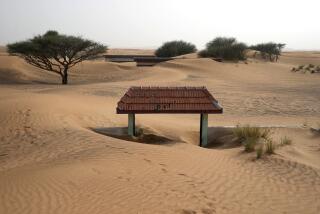Desert Trek Battle of Man Versus Himself
- Share via
CAIRO — It was a trek of exploration, not of the terrain but of themselves.
That is how self-described adventurer Jamie Clarke explained the first expedition of Westerners to dare to cross the Rub al Khali, or the Empty Quarter, of Saudi Arabia on foot and camelback in more than 50 years.
Clarke’s team of three Canadians, three Bedouins and 12 camels stumbled into the oil-glitz emirate of Abu Dhabi last Friday, looking like emissaries from another epoch.
They had set out Feb. 2 from Salalah, an Omani port on the Arabian Sea. For 39 days they had walked and ridden across one of the world’s greatest sand deserts, arguably the harshest terrain on Earth, to retrace the 1946-47 journey of renowned British explorer and travel writer Wilfred Thesiger.
Accompanying Clarke, 31, were his brother Leigh, 33, and their friend, photographer Bruce Kirkby, 31, all from Calgary, Alberta, and the three Bedouins of the Bait Kathir tribe who acted as their guides: Basail Abdullah Kathiri, Salim Kathiri and Salim bin Musalim.
The Empty Quarter is a 225,000-square-mile wasteland that starts near the frontier with Yemen and stretches across most of the southern Arabian Peninsula. Its harshness has defied permanent human habitation. Thesiger called it “a bitter desiccated land that knows nothing of gentleness or ease.”
In summer, temperatures push past 150 degrees in the sun, and even in late winter the heat can be blistering. Clarke recorded a temperature of 117 degrees March 6.
But according to Clarke, that is the kind of physical challenge the explorers were seeking when they set out to cross the Empty Quarter. “The desert became a vehicle for us to conquer ourselves, our fears and our weaknesses,” he said, luxuriating in the comfort of a five-star hotel in Abu Dhabi. “That is the great triumph.”
The Canadians and their guides never faced the same dangers as early travelers. They carried a satellite telephone, emergency beacons and a Global Positioning System locater that allowed them to know exactly where they were in case they needed to summon help. But they did experience the heat, thirst, a paltry diet of dried camel meat and dates, and the aches that come with a camel’s ungainly gait across more than 600 miles of emptiness.
As much as possible, they tried to be self-sufficient. But on a few occasions, they had to have water and fodder brought to them; a 10-year drought has dried up wells and vegetation, Clarke said. The camels were the source of much discomfort: as in falling from camels, being kicked by camels and being spit-up upon by camels.
They successfully negotiated the Uruq al Shaiba, a region of steep sand dunes climbing to 600 feet that was Thesiger’s greatest obstacle. But when they finally arrived in Abu Dhabi, they had to skirt highways and cross concrete barriers before they could take a celebratory plunge into the Persian Gulf with photographers and TV cameras capturing the moment.
How different from Thesiger, now nearing 90, who went about in secret, armed and wary, because of the dangers of tribal fighting and brigandage in the pre-petroleum days.
Thesiger wrote presciently in 1950: “I went to southern Arabia only just in time. Others will go there to study geology and archeology, the birds and plants and animals, even to study the Arabs themselves, but they will move about in cars and will keep in touch with the outside world by wireless.
“They will bring back results far more interesting than mine, but they will never know the spirit of the land nor the greatness of the Arabs.”
Like Thesiger and his Bedouin companions, the Canadians carried their water in goatskins. But they also had the advantages of technology--in addition to the telephone, they carried a laptop computer that enabled them to write reports for their journey’s Web page: https://www.alwaysadventure.net.
The exhilarated Clarke, who intends to write a book about the adventure, rued that the untrammeled wilderness described by Thesiger has vanished. “Today,” he noted, “much of the Empty Quarter is crisscrossed with the tracks of four-wheel-drive vehicles.”
More to Read
Sign up for The Wild
We’ll help you find the best places to hike, bike and run, as well as the perfect silent spots for meditation and yoga.
You may occasionally receive promotional content from the Los Angeles Times.






